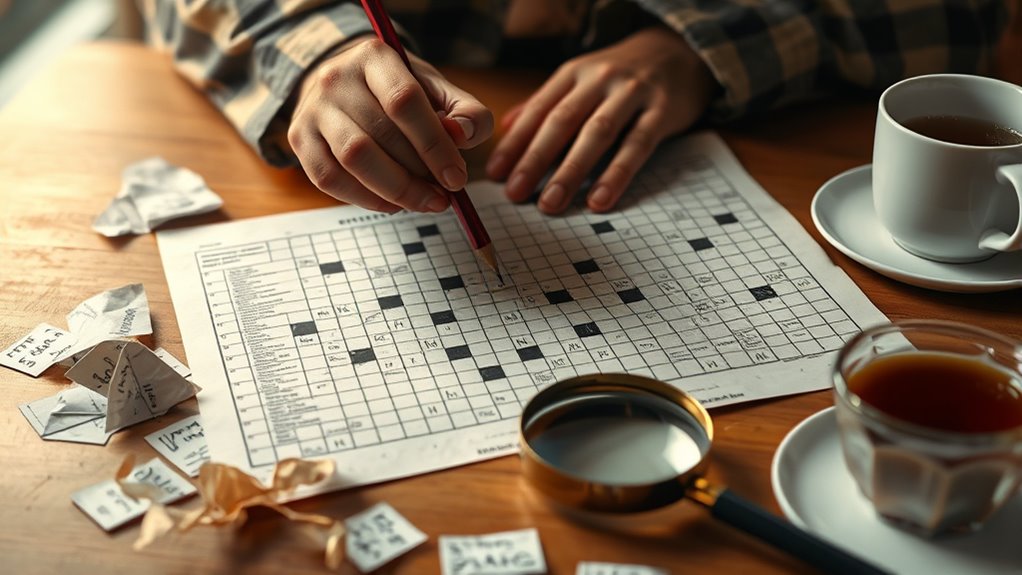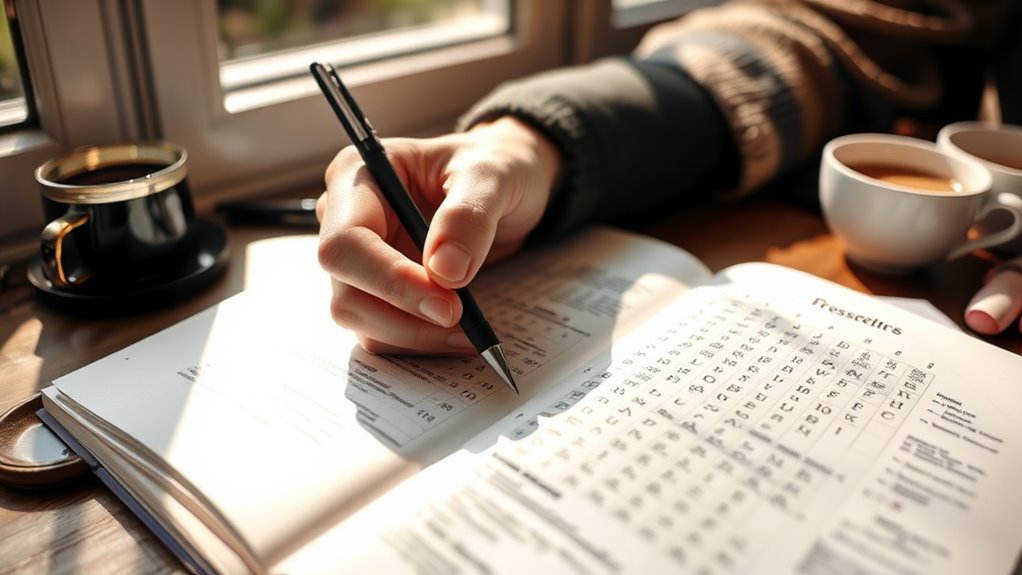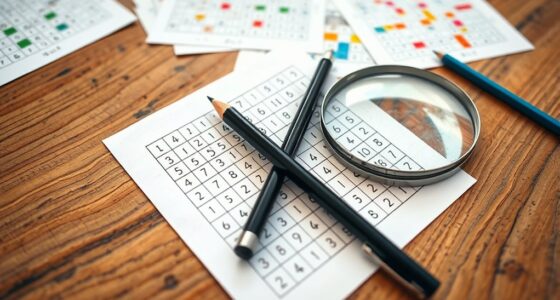To solve cryptic crosswords effectively, start by identifying clear clues and parsing them carefully, recognizing indicator words like “rearranged” or “hidden.” Focus on easier clues first to establish crossing letters, then use those to verify or eliminate options for tougher words. Revisit and reparse clues if contradictions arise, and let crossing letters guide your choices. Keep practicing these strategies, and you’ll uncover more techniques to crack even the most challenging puzzles.
Key Takeaways
- Break down each clue into definition and wordplay to identify the solving approach.
- Recognize indicator words like “rearranged,” “hidden,” or “sounds like” to determine clue mechanisms.
- Fill in confident answers first, then use crossing letters to verify or eliminate options.
- Prioritize easier clues to establish grid anchors before tackling more challenging ones.
- Revisit and reparse clues as needed, leveraging intersecting answers to refine solutions.

Cryptic crosswords can seem intimidating at first, but with the right strategies, they become much more manageable. The key to cracking these puzzles lies in mastering clue parsing and efficient grid filling. When you approach a cryptic clue, don’t rush to solve it immediately. Instead, break it down into parts: look for potential anagrams, hidden words, or charades. Clue parsing involves identifying the definition, which is often at one end of the clue, and the wordplay, which provides a way to construct the answer. Recognizing indicator words like “rearranged,” “hidden,” or “sounds like” helps you determine whether the clue involves an anagram, a hidden word, or a homophone. Practice parsing clues methodically, and over time, you’ll start to see patterns and common indicator words that make decoding faster. Additionally, familiarizing yourself with common cryptic clue conventions can significantly improve your solving efficiency.
Once you’ve parsed a clue and identified a potential answer, focus on grid filling. Filling the grid isn’t just about finding the right words; it’s about fitting them correctly within the constraints. Start with the clues you’re most confident about, especially those with crossing letters already filled in, because they provide helpful hints for neighboring answers. As you fill in words, verify that they fit with intersecting clues, which can often confirm or deny your guesses. If you encounter a contradiction, revisit the clues involved and re-examine your parsing. Sometimes, a small reconsideration of a single clue can open up the entire grid.
Start with confident clues, verify intersections, and revisit your parsing to efficiently fill the grid.
Additionally, keep track of the words you’ve already placed. They can serve as anchors for solving more challenging clues later on. Use the crossing letters to narrow down options—if a certain letter must be an ‘A’ based on crossing words, eliminate options that don’t fit. Don’t be afraid to leave some clues temporarily unanswered; returning with fresh eyes after filling in easier answers often reveals new possibilities. Over time, you’ll develop an intuition for which clues to tackle first and how to leverage the grid’s structure for efficient filling.
In essence, mastering clue parsing combined with strategic grid filling transforms cryptic crosswords from an intimidating puzzle into an engaging challenge. Approach each clue methodically, use the crossing letters to your advantage, and stay patient. With practice, you’ll find yourself solving puzzles more quickly and confidently, enjoying the intricate dance of wordplay and logic that makes cryptic crosswords so rewarding.
Frequently Asked Questions
How Do I Identify the Definition and Wordplay in Clues?
To identify the definition and wordplay in clues, start by analyzing the clue structure carefully. Usually, the definition is at one end, either the beginning or the end of the clue. Then, distinguish the surface meaning from the wordplay, which often involves anagrams, charades, or puns. Look for indicator words that signal word manipulation. Practice helps you become better at recognizing these elements, making solving more intuitive.
What Are Common Abbreviations Used in Cryptic Crosswords?
You’ll find common abbreviations in cryptic crosswords follow specific abbreviation patterns and shorthand conventions. For example, “R” often stands for “are,” “DR” for “doctor,” and “L” for “left.” You might see “kg” for “kilogram,” “oz” for “ounce,” or “yr” for “year.” Familiarizing yourself with these common abbreviations helps you recognize wordplay faster and makes solving clues more efficient.
How Can I Improve My Pattern Recognition Skills?
To improve your pattern recognition skills, focus on practicing puzzles regularly and analyzing the clues carefully. Use visual pattern recognition by noticing common word patterns, letter arrangements, and recurring abbreviations. Incorporate puzzle-solving techniques like breaking down complex clues into smaller parts and identifying synonyms or abbreviations quickly. Over time, you’ll start recognizing familiar patterns more easily, making your solving process more efficient and enjoyable.
Are There Specific Strategies for Tackling Particularly Difficult Clues?
When faced with tough clues, don’t throw in the towel. Instead, use techniques for obscure clues by breaking them down into smaller parts and analyzing wordplay carefully. Look for hidden thematic hints that might point you toward the answer. Practice patience and stay flexible—sometimes thinking outside the box helps crack even the trickiest puzzles. Keep at it, and you’ll find yourself solving clues that once seemed impossible.
How Do I Effectively Use Crossing Letters to Solve Clues?
You should use crossing letters to narrow down your options and decipher partial solutions. When you have some letters filled in, look at how they fit with the clue’s definition and wordplay. Cross-referencing these letters helps you eliminate unlikely options and confirms correct answers. Focus on deciphering partial solutions first, then use the crossing letters to piece together the remaining parts of the word more confidently.
Conclusion
Now that you’ve uncovered some secret charms of cryptic crosswords, you’re like a detective with a treasure map, ready to uncover hidden gems. Trust your instincts, embrace the twists and turns, and don’t be afraid to dance with wordplay. Each solved puzzle is a small victory, a spark that ignites your puzzle-solving spirit. Keep practicing, and soon, these mysterious riddles will feel less like puzzles and more like a familiar melody in your mind’s symphony.









